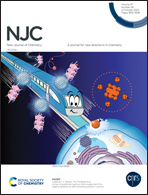Arrays of graphene-quantum dots-supported DNA oligonucleotides as self-indicating porphyrin carriers†
Abstract
The functionalization of deoxyribonucleic acid (DNA) with nanomaterials is a promising strategy to optimize the loading and efficiency of drugs in targeted clinical therapies. Herein we report a novel approach to construct arrays comprising blue- (B) or aqua green- (AG) emitting ethylenediamine-modified graphene quantum dots (GQDs) and DNA oligonucleotides that are able to fold into different structures, namely G-quadruplexes (G4s). The obtained results indicate that GQDs partially modulate the conformation of oligonucleotides, resulting in GQDs-DNA bioconjugates with higher affinity to carry 5,10,15,20-tetrakis(1-methylpyridinium-4-yl)porphyrin (TMPyP), in comparison to non-modified DNA sequences. TMPyP shows a higher affinity, expressed by a lower dissociation constant (KD), to GQDs-B-G4-1 (0.229 μM) and to GQDs-AG-G4-1 (KD of 0.326 μM) in comparison with non-modified G4-1 (KD of 0.440 μM). The carrier systems with the highest affinity to TMPyP correspond to GQDs-AG with telomeric unimolecular G4 sequence (GQDs-AG-G4-2, KD of 0.111 μM) and GQDs-AG with a non-G4 sequence (GQDs-AG-non-G4, KD of 0.110 μM), followed by their analogues with GQDs-B. While uncovering terra incognita, it is anticipated that GQDs-DNA arrays may be potential photoluminescent nanovehicles to carry other cationic anticancer drugs and allow more targeted therapies.



 Please wait while we load your content...
Please wait while we load your content...